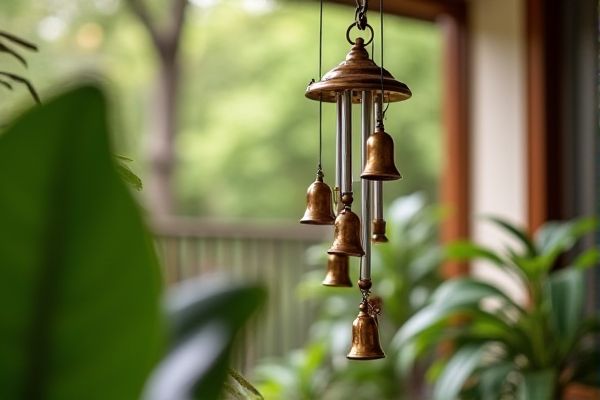
Wind chimes produce soothing, melodic tones that enhance ambiance and promote relaxation, while hanging bells typically create sharp, clear sounds often used for signaling or decorative purposes. Discover which option best suits your outdoor space and personal taste by reading the rest of our in-depth comparison.
Table of Comparison
| Feature | Wind Chimes | Hanging Bells |
|---|---|---|
| Material | Metal, wood, or bamboo tubes | Metal or brass |
| Sound | Soft, melodic, harmonic tones | Loud, clear, ringing tones |
| Purpose | Decorative, relaxation, feng shui | Alert, ceremonial, decorative |
| Design | Multiple suspended tubes or rods | Single bell or cluster of bells |
| Placement | Porches, gardens, patios | Doorways, temples, homes |
| Durability | Weather-resistant if quality material | Highly durable, long-lasting metal |
| Price Range | Low to mid-range | Mid to high-range |
Introduction to Wind Chimes and Hanging Bells
Wind chimes create soothing melodies through suspended tubes or rods that respond to wind movement, enhancing outdoor ambiance with gentle sounds. Hanging bells, often crafted from metal or ceramic, produce clearer, ringing tones when struck, commonly used as decorative elements or for signaling. Both wind chimes and hanging bells serve aesthetic and auditory purposes, but their sound profiles and design materials differ significantly.
Historical Origins and Cultural Significance
Wind chimes have origins dating back to ancient China, where they were believed to ward off evil spirits and attract positive energy, while hanging bells trace back to early Buddhist temples in India, serving both ritualistic and protective purposes. In Japanese culture, wind chimes called "furin" are cherished for their soothing sounds during summer and are symbols of good fortune. Hanging bells in Western traditions often signify spiritual awakening and are used in ceremonies to invoke tranquility and mindfulness.
Materials Used: Wood, Metal, and Beyond
Wind chimes are crafted from diverse materials such as bamboo, aluminum, and copper, each producing distinct tones that enhance ambient soundscapes. Hanging bells typically utilize metals like brass and bronze, offering a resonant, melodic ring favored in spiritual and decorative settings. Innovations in materials include glass and recycled components, expanding aesthetic options and sound variations for both wind chimes and hanging bells.
Sound Differences: Tones and Resonance
Wind chimes produce soft, melodic tones with varied resonance depending on the materials used, creating a soothing ambient sound that gently fills your space. Hanging bells typically emit sharper, clearer tones with a more pronounced resonance, offering a crisp and often rhythmic auditory experience. Understanding these sound differences helps you choose between the delicate harmony of wind chimes or the vibrant clarity of hanging bells for your outdoor or indoor environment.
Aesthetic Appeal: Design Variations
Wind chimes offer a diverse range of design variations, including metal, bamboo, glass, and ceramic elements that produce harmonious sounds while enhancing outdoor decor. Hanging bells often feature intricate metalwork and traditional motifs, providing both visual charm and a soothing tonal quality. Your choice depends on whether you prioritize a modern, artistic aesthetic or a classic, ornamental appeal.
Placement: Indoor vs Outdoor Options
Wind chimes are ideal for outdoor placement, where natural breezes activate their melodic tones, enhancing gardens, patios, and balconies. Hanging bells can be used both indoors and outdoors; indoors, they add decorative charm and subtle sound near entryways or windows, while outdoors, they create a gentle auditory ambiance in porches or tree branches. Choosing placement depends on exposure to wind and desired sound intensity, with wind chimes requiring open-air environments and hanging bells offering versatile options in diverse settings.
Symbolism and Spiritual Meaning
Wind chimes symbolize harmony, peace, and positive energy in many cultures, often used to attract good luck and ward off negative spirits. Hanging bells carry spiritual significance by clearing stagnant energy and inviting divine presence during meditation or rituals. Both objects serve as tools for mindfulness, with wind chimes emphasizing balance and tranquility, while bells focus on purification and sacred sound.
Maintenance and Durability Comparison
Wind chimes crafted from aluminum or titanium require minimal maintenance and resist rust, ensuring long-lasting durability in outdoor conditions. Hanging bells often made from brass or bronze can develop patina over time, demanding occasional cleaning to preserve their aesthetic appeal. Both options offer sturdy construction, but wind chimes generally provide better weather resistance with less upkeep.
Environmental Impact and Sustainability
Wind chimes made from natural materials like bamboo or recycled metal generally have a lower environmental impact compared to hanging bells, which often require energy-intensive manufacturing processes and non-recyclable components. Sustainable choices include wind chimes crafted from eco-friendly materials that minimize waste and promote biodegradability. Your selection affects long-term environmental sustainability, making wind chimes a greener option for outdoor decor.
Choosing the Right Option for Your Space
Wind chimes create soothing, melodic tones that enhance outdoor tranquility, while hanging bells offer a more resonant sound ideal for spiritual or decorative purposes. Consider your space's ambiance and acoustic preferences--wind chimes work well in gardens and patios, whereas hanging bells suit entryways or meditation areas. Selecting the right option depends on whether you seek gentle relaxation or a more pronounced auditory presence for your environment.
 homyna.com
homyna.com